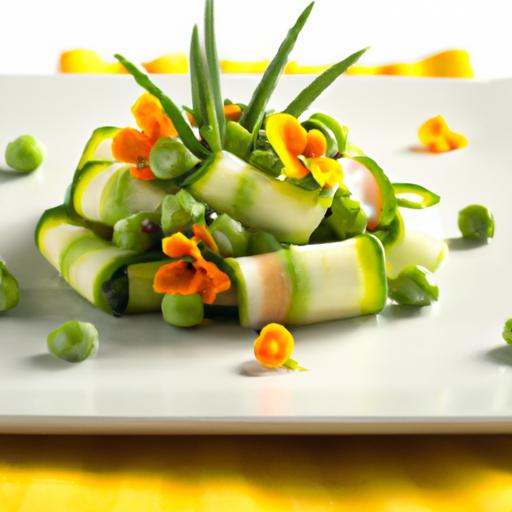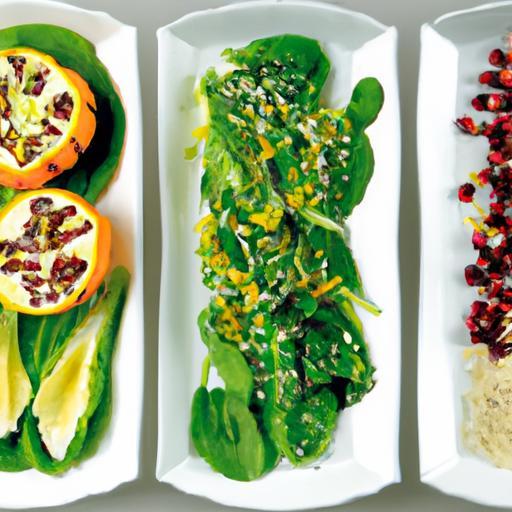In the vibrant world of culinary artistry, the magic often lies in the balance between nature’s freshest gifts and the rich, concentrated flavors of preserved ingredients. “Mastering Meals: Blending Fresh and Preserved Flavors Perfectly” invites you on a journey through the fascinating interplay of textures, tastes, and aromas that can transform everyday dishes into extraordinary experiences. Whether it’s the zing of sun-ripened tomatoes paired with the smoky depth of cured olives, or the crisp snap of garden-picked herbs weaving seamlessly with the mellow warmth of aged cheeses, mastering this harmony unlocks a realm where tradition meets innovation. Join us as we explore the secrets, techniques, and inspirations behind crafting meals that sing with the perfect fusion of fresh and preserved flavors.
Mastering Meals: Blending Fresh and Preserved Flavors Perfectly
Mastering meals involves an exquisite dance of blending fresh and preserved flavors perfectly, where the vibrant brightness of seasonal ingredients meets the rich, complex depth of pantry staples. This culinary technique is more than just a method-it’s an art form that transforms ordinary dishes into unforgettable experiences. My journey with flavor fusion began long ago, inspired by the rustic kitchens of southern Europe, where fresh herbs meet sun-dried tomatoes, and tangy preserved lemons elevate every bite. The key lies in balance: harmonizing textures and tastes for a dish that sings cohesively.
Prep and Cook Time
- Preparation: 15 minutes
- Cooking: 30 minutes
- Total: 45 minutes
Yield
- Serves 4
Difficulty Level
- Medium
Ingredients
- 2 tablespoons extra virgin olive oil
- 1 medium yellow onion, finely chopped
- 3 cloves garlic, minced
- 1 cup sun-dried tomatoes, finely chopped
- 1 preserved lemon, rind only, thinly sliced
- 400g (14 oz) fresh cherry tomatoes, halved
- 1 teaspoon smoked paprika
- 200g (7 oz) spinach leaves, washed and roughly chopped
- 1/2 cup toasted pine nuts
- 150g (5 oz) crumbled feta cheese
- Salt and freshly ground black pepper to taste
- Fresh basil leaves for garnish
- Freshly baked crusty bread for serving
Instructions
- Heat the olive oil in a large skillet over medium heat. Add the chopped onion and sauté until translucent, about 5 minutes.
- Add minced garlic and cook for 1 minute until fragrant, taking care not to burn it.
- Stir in sun-dried tomatoes and preserved lemon slices. Sauté for 3 minutes, allowing the preserved elements to release their intense flavor.
- Add the halved cherry tomatoes and smoked paprika. Cook for 7-10 minutes, stirring occasionally, until cherry tomatoes soften and release their juices, forming a luscious sauce.
- Fold in the chopped spinach, letting it wilt gently in the pan. Season with salt and freshly ground black pepper to taste.
- Remove from heat and sprinkle toasted pine nuts and crumbled feta over the top. Gently toss to combine the textures and flavors.
- Serve warm, garnished with fresh basil leaves alongside slices of crusty bread to soak up every drop of the flavorful fusion.
Chef’s Notes: Tips for Success
- Preserved Lemon Substitution: If preserved lemons aren’t available, zest a fresh lemon and add a teaspoon of lemon juice for brightness, though the salty tang of preserved lemon is unmatched.
- Nut Alternatives: Swap pine nuts with toasted almonds or walnuts for a different crunch.
- Make-Ahead: Prepare the sun-dried tomato and preserved lemon base up to two days ahead; flavors intensify beautifully with time.
- Vegetarian Protein Boost: Add cooked chickpeas or white beans to complement fresh and preserved flavors while adding texture.
- Balancing Flavors: Taste as you go-preserved ingredients can be intensely salty; balance with fresh tomatoes or a splash of cream if needed.
Serving Suggestions
Present this dish in a rustic shallow bowl to showcase the vibrant colors and textures. Garnish with extra basil leaves and a light drizzle of high-quality olive oil. Pair it with a chilled glass of Sauvignon Blanc or a light rosé for a fresh, uplifting contrast. This fusion shines best served alongside warm, crusty bread or a bright arugula salad with lemon vinaigrette, highlighting the dish’s balance of fresh and preserved elements.
| Nutrient | Per Serving |
|---|---|
| Calories | 320 kcal |
| Protein | 10 g |
| Carbohydrates | 15 g |
| Fat | 25 g |

For further exploration, visit our guide on seasonal ingredient pairings to deepen your skills in flavor combination. Additionally, discover expert insights on food preservation techniques at USDA National Institute of Food and Agriculture for trusted, science-backed guidance.
Q&A
Q&A: Mastering Meals – Blending Fresh and Preserved Flavors Perfectly
Q1: Why should I combine fresh and preserved ingredients in my cooking?
A1: Combining fresh and preserved ingredients creates a dynamic flavor profile that is both vibrant and deeply satisfying. Fresh ingredients bring brightness, texture, and natural aroma, while preserved items-such as pickles, cured meats, or fermented sauces-add complexity, umami, and depth. Together, they elevate ordinary dishes into extraordinary culinary experiences.
Q2: What types of preserved flavors work best with fresh ingredients?
A2: The best preserved flavors complement rather than overpower fresh ones. Think tangy pickled vegetables paired with crisp greens, salty anchovies enhancing fresh tomatoes, or tangy fermented kimchi balancing mild, fresh proteins. Experiment with cured olives, smoked salts, aged cheeses, or fermented soy products to find your flavor symphony.
Q3: How do I balance the intensity of preserved flavors with fresh components?
A3: Balance is key. Start with small amounts of preserved items and taste as you go. Use fresh ingredients to mellow intense, salty, or sour notes. For example, fresh herbs or a squeeze of citrus can brighten rich, preserved flavors. Remember, layering flavors gradually helps you create harmony rather than clash.
Q4: Can blending fresh and preserved flavors help with meal prep and storage?
A4: Absolutely! Preserved ingredients extend your pantry’s versatility and reduce waste by adding life to meals when fresh items are limited. Combining fresh produce with preserved staples means you can whip up delicious, balanced dishes even when time is tight or seasonal fresh options are scarce.
Q5: Are there cultural cuisines that excel in this technique?
A5: Many world cuisines master this art-think Mediterranean dishes combining fresh veggies with salted anchovies or roasted olives, Korean meals pairing fresh greens with pungent kimchi, or Japanese cooking blending fresh fish with fermented miso and soy. Exploring these traditions can inspire your own blending experiments.
Q6: Any tips for someone new to blending fresh and preserved flavors?
A6: Start simple. Pick one fresh and one preserved ingredient to pair. Focus on contrasting and complementing textures and tastes. For instance, a fresh garden salad with preserved lemon vinaigrette or avocado toast topped with a few slices of cured ham. With practice, intuition for balancing these flavors will grow naturally.
Q7: How does this blending impact the nutritional value of meals?
A7: Combining fresh with preserved can enhance nutrition-fresh veggies deliver vitamins and crunch, while fermented or preserved foods often provide probiotics, beneficial enzymes, and concentrated minerals. Just be mindful of sodium levels in preserved ingredients and balance your dish accordingly.
Q8: Can this method work for all meals-breakfast, lunch, and dinner?
A8: Definitely! From a breakfast omelet with fresh herbs and smoked salmon to a lunch salad with fresh greens and pickled beets, to a dinner of fresh pasta tossed with aged cheese and sun-dried tomatoes-the possibilities are vast. Blending fresh and preserved flavors adds excitement and depth to every meal of the day.
Q9: Where can I find preserved ingredients if I want to try this at home?
A9: Specialty grocery stores, farmers’ markets, and international food shops often carry a treasure trove of preserved delights. You can also easily make your own pickles, fermented veggies, or preserved herbs at home-turning your kitchen into a flavor laboratory.
Q10: What’s the ultimate goal when mastering meals with fresh and preserved flavors?
A10: The goal is to craft dishes that sing with balanced, layered tastes-meals that feel both comfortingly familiar and refreshingly new. By skillfully blending the crisp brightness of fresh with the savory depth of preserved, you create culinary magic that delights every palate and transforms everyday eating into an art.
Concluding Remarks
As you embark on your culinary adventures, remember that mastering meals is an art of harmony-where the vibrant zest of fresh ingredients dances seamlessly with the comforting depth of preserved flavors. By thoughtfully blending these elements, you not only unlock a world of taste but also celebrate the timeless rhythms of nature and tradition. Whether you’re crafting a weeknight dinner or an elaborate feast, this balance transforms every bite into a story, inviting your palate to savor the past and present in perfect symphony. So go forth, experiment boldly, and let your kitchen become a canvas where freshness and preservation create unforgettable meals.


